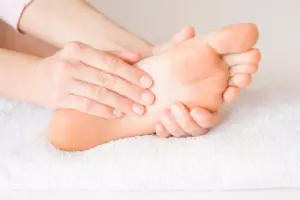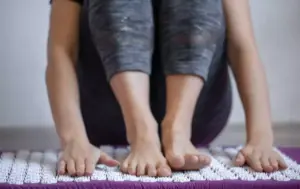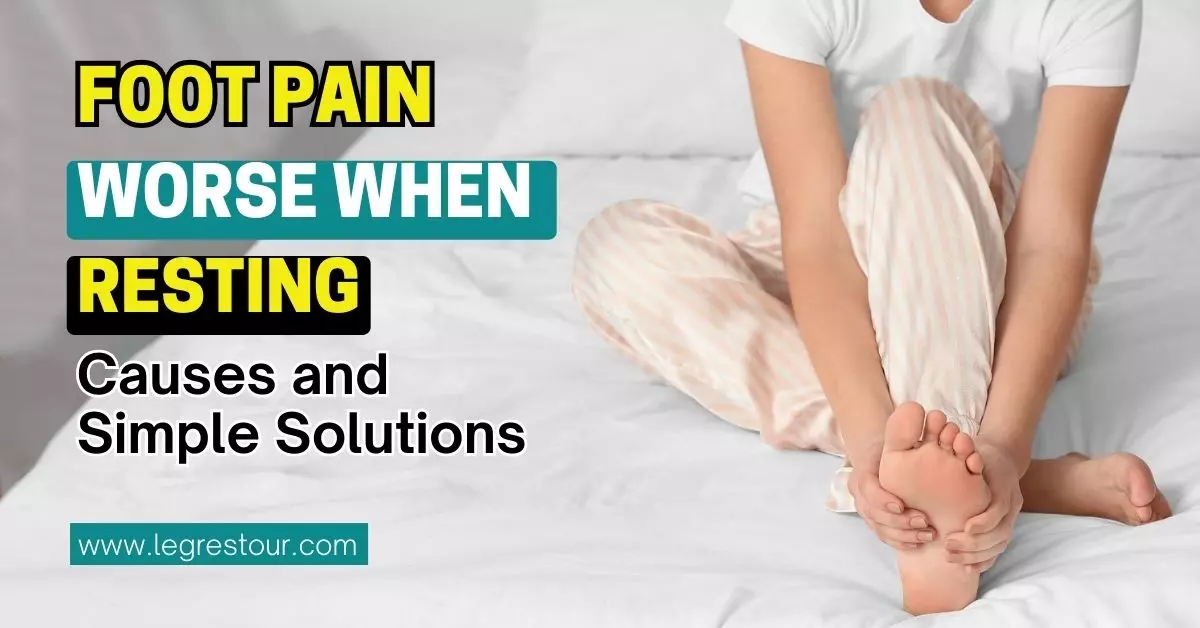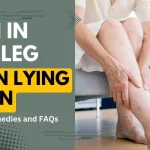Foot discomfort is a frequently encountered ailment that can significantly disrupt our daily lives. Whether it’s a consistent ache or an abrupt acute twinge, foot discomfort can be both bothersome and disconcerting. What heightens the enigma is when the discomfort appears to magnify during moments of repose. In this exhaustive guide, we will delve into the Foot Pain Worse When Resting, dissecting its sundry forms and exploring the shared origins behind why it becomes more conspicuous when we’re not in motion.
Kinds of Foot Discomfort
Identifying Diverse Forms of Foot Discomfort
Foot discomfort is by no means a uniform experience. It manifests in an assortment of ways, and understanding the essence of your unease is the primary step to discovering solace. It can range from a persistent ache to a searing, prickling sensation, or even intense, puncturing agonies.
Transition: Now that we have a comprehension of the varied perceptions linked with foot discomfort, let’s delve more profoundly into each classification.
Lingering and Throbbing
Lingering and throbbing foot discomfort are frequently affiliated with ailments like plantar fasciitis or overexertion injuries. This class of discomfort appears to deteriorate when you’re at rest, possibly due to inflammation subsiding during periods of inactivity.
Ablaze and Prickling
Ablaze and prickling sensations are often correlated with neuropathy, a condition involving nerve impairment. The sensation can be exacerbated when at rest since there are fewer distractions.
Incisive and Piercing
Incisive, piercing foot discomfort can be indicative of various concerns, such as stress fractures or conditions like gout. The discomfort may become more discernible when at rest due to diminished circulation in the affected region.
Conventional Causes of Foot Discomfort That Aggravates at Rest

Plantar Fasciitis
One of the leading perpetrators behind the exacerbation of foot discomfort at rest is plantar fasciitis. This condition involves inflammation of the plantar fascia, a thick band of tissue that links the heel bone to the toes.
Transition: Now, let’s investigate other frequent causes that contribute to foot discomfort when at rest.
Arthritis
Arthritis can influence the joints in your feet, resulting in discomfort and rigidity. The anguish may be more conspicuous during phases of idleness, such as when arising from slumber in the morning.
Neuropathy
Neuropathy, or nerve damage, can lead to heightened discomfort at rest. This is because your nerves may become more sensitive without the diversion of movement.
Overexertion and Fatigue
Overexertion and fatigue can also give rise to increased foot discomfort when you’re not active. The tissues in your feet may become inflamed and necessitate recuperation.
Risk Factors and Prevention
Identifying Who Is Vulnerable
Comprehending the risk factors for foot discomfort can aid you in taking anticipatory measures to avert it. Variables like age, body weight, and profession can affect your probability of undergoing foot unease.
Transition: Equipped with knowledge concerning the risk factors, let’s scrutinize methods to thwart and oversee foot discomfort.
Lifestyle Modifications
Effectuating lifestyle alterations can substantially curtail your probability of developing foot discomfort. Preserving a healthy body weight, staying physically active, and donning suitable footwear are all pivotal elements to take into account.
Footwear Considerations
Your choice of footwear plays a pivotal role in foot well-being. Invest in well-fitted, supporting shoes that correspond to your actions and foot type.
Exercising and Stretching
Engaging in particular exercises and stretching can fortify your feet and diminish the risk of discomfort. These exercises can also alleviate existing anguish.
Diagnosis and Medical Assessment
When to Seek Medical Aid
Recognizing when it’s time to solicit medical assistance is crucial. If your foot discomfort endures, exacerbates, or is accompanied by other alarming symptoms, seek medical attention promptly.
Transition: Let’s now plunge into the medical assessment procedure to discern the root cause of your foot discomfort.
Medical Assessment Process
A medical assessment customarily encompasses a thorough scrutiny of your feet, a review of your medical past, and might encompass imaging tests like X-rays or MRI scans.
Imaging and Tests
These diagnostic tools can afford an intricate view of your foot’s internal structures, aiding your healthcare provider in pinpointing the precise cause of your discomfort.
Treatment Alternatives
Conventional Remedies
Numerous instances of foot discomfort can be effectively managed with conventional treatments such as rest, cryotherapy, compression, and elevation (RICE), physical therapy, and personalized orthotics.
Transition: In more severe cases, or when conventional treatments fall short, more assertive approaches may be requisite.
Pharmaceuticals
Pharmaceutical choices, including analgesics and anti-inflammatory drugs, can furnish respite from foot discomfort. Your healthcare provider will establish the most pertinent medication for your condition.
Physical Therapy
Physical therapy can be profoundly advantageous for individuals grappling with foot discomfort. Therapists can prescribe exercises and methods to augment foot vigor and flexibility.
Surgical Interventions
In some instances, surgical procedures may be obligatory to rectify underlying issues adding to foot discomfort. Your healthcare provider will deliberate on surgical choices if they are deemed apropos.
Lifestyle and Home Cures

Self-Attentiveness Practices
Incorporating self-attentiveness practices into your everyday regimen can be a game-changer in managing foot discomfort. These may encompass massage, proper foot sanitation, and observing your symptoms.
Transition: Let’s scrutinize two self-attentiveness practices in more detail.
Repose and Elevation
Setting aside time to rest and elevate your feet can diminish inflammation and mitigate discomfort.
Cryotherapy and Thermotherapy
Alternating between cryotherapy and thermotherapy can furnish respite from discomfort and inflammation. Apply cryotherapy for 15-20 minutes, succeeded by a heat source for equivalent durations.
Coping with Persistent Foot Discomfort
Psychological Impact
It’s crucial to recognize the psychological toll that persistent foot discomfort can exact. Contending with continual discomfort can incite sentiments of frustration and potentially despondency.
Transition: Seek support and contemplate strategies to heighten your quality of life despite unceasing discomfort.
Support Networks
Constructing a support network that encompasses companions, family, and healthcare professionals is pivotal for managing continuous foot discomfort.
Lifestyle Adjustments
Tailoring your everyday schedule, interests, and activities can aid in adapting to a life with persistent foot discomfort. Consider exploring alternative methods of exercise and leisure pursuits.
In closure, foot pain worse when resting can be a formidable predicament to manage. Yet, with the appropriate insight and approach, relief is attainable. By comprehending the manifold kinds and sources of foot discomfort, recognizing risk factors, soliciting timely medical assessment, and investigating treatment alternatives, you can seize command of your foot well-being. Keep in mind that managing foot discomfort is a voyage, and with patience and perseverance, you can look forward to days with reduced discomfort and amplified mobility.
It’s also important for you: The Ultimate Guide to Choosing the Best Foot Massager for Wide Feet
Frequently Asked Questions (FAQ)
1: Can foot discomfort be indicative of a more severe underlying condition?
Yes, foot discomfort can sometimes be an indicator of a more severe underlying issue. If your foot discomfort is persistent, worsening, or accompanied by other disconcerting symptoms, it’s crucial to solicit medical evaluation to eliminate severe conditions.
2: How can I forestall foot discomfort when I’m on my feet all day for work?
To thwart foot discomfort stemming from prolonged standing or ambulation, contemplate donning comfortable and supportive shoes, taking regular intermissions to rest and extend your feet, and performing strengthening exercises to buttress your foot’s arches.
3: Are there any specific exercises that can aid in alleviating foot discomfort?
Yes, exercises like toe contractions, ankle rotations, and calf stretches can fortify the muscles and ligaments in your feet, diminishing the risk of discomfort and distress.
4: When should I contemplate surgery for my foot discomfort?
Surgery is generally considered when conventional treatments have proven ineffective in providing respite, and the root cause of foot discomfort necessitates correction. Your healthcare provider will confer surgical alternatives if deemed essential.



